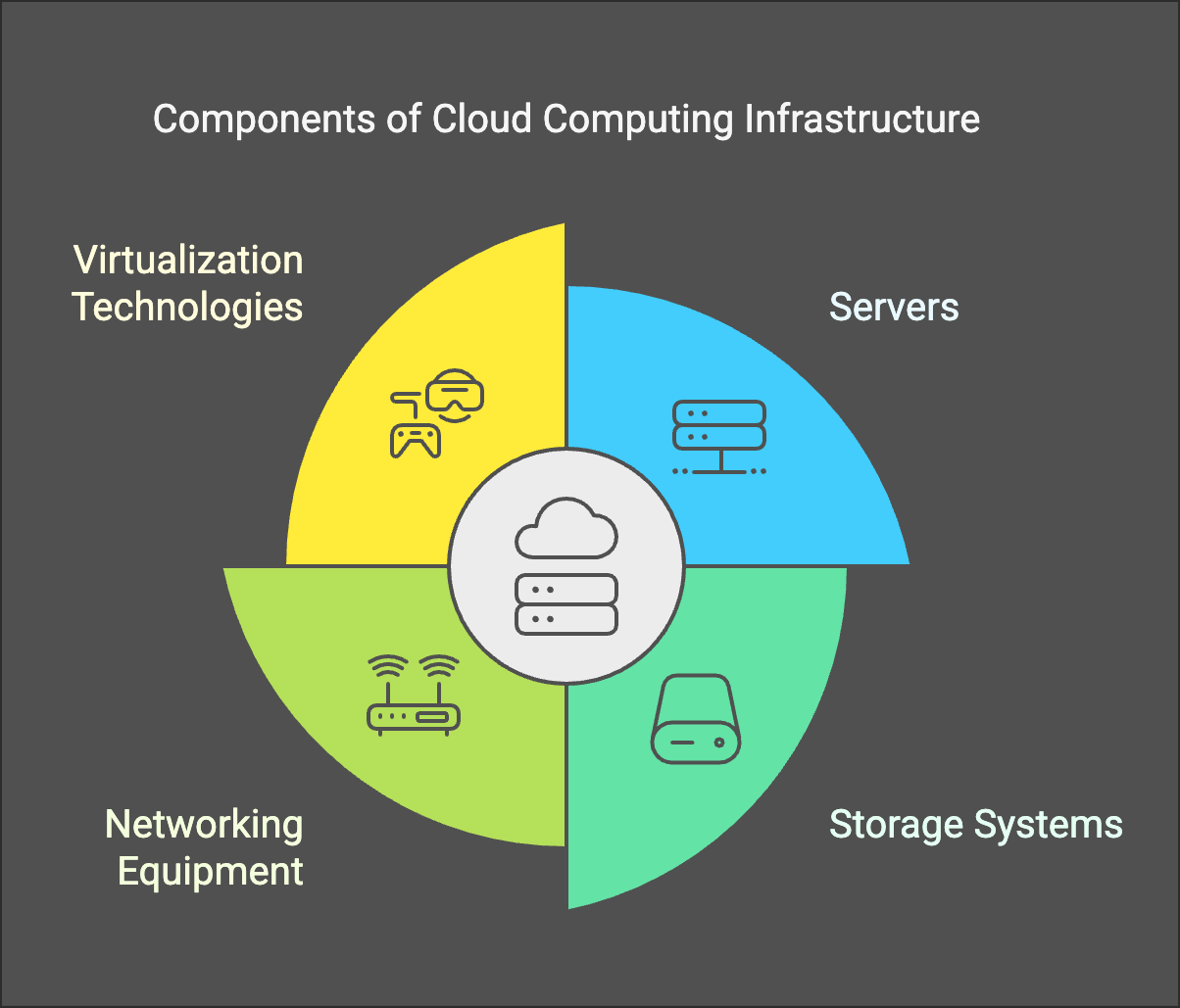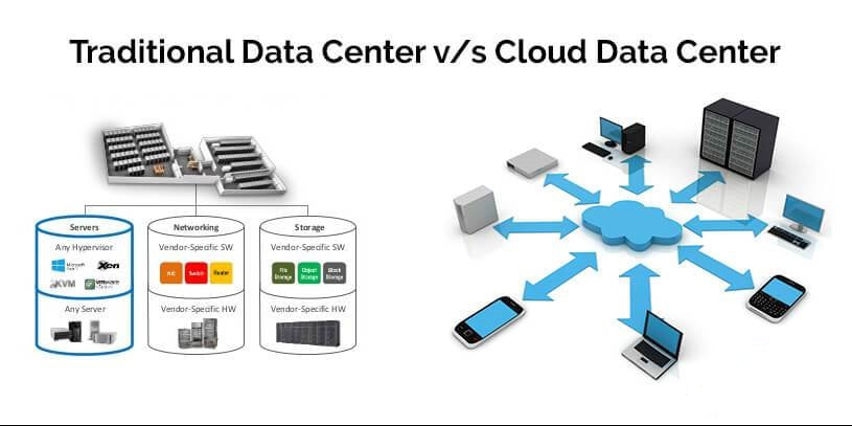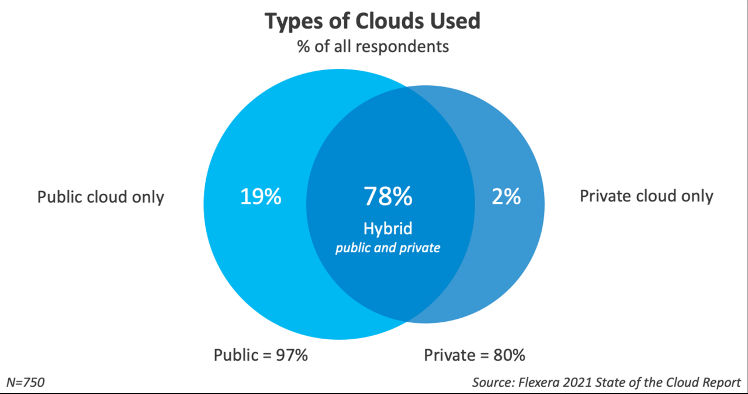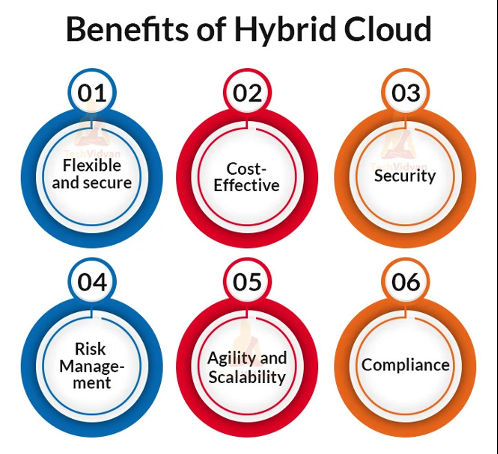Cloud Computing
Overview
Cloud computing refers to the delivery of information technology (IT) services using internet technologies in a way that is elastic and scalable and may be priced on a pay-as-you-go basis. Core cloud computing services generally include data storage, processing capacity, networking and software applications. Many of these services are similar to utility services in that they are largely commoditized and can be consumed in small or large quantities as is needed.
Components of Cloud Computing Infrastructure
The major components that make up the cloud infrastructure are:

Hardware
Hardware includes the equipment needed to connect machines to a single cloud. Hardware components include servers, power supplies, memory and storage, and central processing units (CPUs). All of these features need to work together to provide the performance, security, and availability cloud users need.
Virtualization
Virtualization makes it possible to decouple computing infrastructure from the hardware that runs them. This is perhaps the most important part of a cloud infrastructure. Virtualization software plays an essential role, because it decouples data storage and computing power from the hardware itself. Virtualization also allows operators to manage their cloud infrastructure through a central user interface.
Storage
Cloud storage holds data, keeps the latest version of a file or data item and possibly also previous versions, and enables remote access as needed. Virtualization provides a link between hardware and cloud storage, enabling the three major cloud storage models: - Block storage?sorts data into blocks instead of complete files. This is an ideal solution for storing data that is static and does not change regularly. - File storage?like the file manager systems used with regular PCs. - Object storage?suitable for storing unstructured data, or data that needs to frequently change.
Network
Network infrastructure is also important for providing cloud computing services. This includes both internal networks, within the cloud environment, and external network connections to enable remote access. Network infrastructure covers many different types of hardware, including routers, switches, load balancers, and physical cables.
Traditional Infrastructure or Cloud Platform
Cloud based services are gaining in more demand as it gives you the flexibility to scale up or down your cloud capacity, powerful disaster recovery mechanism and reduce cost of hardware. You simply pay as you go and enjoy a subscription based model to handle your cash flow efficiently and reduce your initial capital investment.
Cloud providers are taking care of all the software / hardware updates so you don?t have to waste time in maintaining these systems. Cloud services give you the flexibility of deploying your application globally across the world considering your regional requirements. The data stored on the cloud can be accessible across the world through secure data network provided by different cloud providers.

Advantages of Cloud Computing
In addition to the overall cost-efficiency for the end user, using cloud infrastructure has a number of key advantages:
-
Flexibility: Users aren't limited to a single device or a single location. With the right security measures in place, anything that's in the cloud can be accessed anywhere there's an active internet connection.
-
Data storage and backup: Information that is kept in any type of cloud storage is insulated from data loss or destruction of a business's physical location. On the provider side, data is fragmented across multiple locations to limit the risk of data loss.
-
Application building and testing: The scalability of cloud infrastructure adjusts to changing needs during the development and testing process, reducing both cost and time.
-
Software on demand: When the actual software is stored in the cloud, any software updates only need to be done on the provider side, giving the end user immediate access to the latest version.
Cloud Deployment Models
Organisations may adopt different cloud models, depending on their needs and preferences. Each model provides different features and implies different trade-offs. Models are generally categorized into the following:
Public Cloud:
In this model, cloud services are made available virtually over the internet to users and are operated by a cloud service provider. The cloud provider hosts and operates the physical servers and locates them in multiple locations to provide improved resiliency capabilities. Depending on the level of service, they may also manage the operating system, middleware, and various application layers on top of the physical infrastructure. In this model, because cloud providers run large data centers, users are able to quickly provision needed computational resources, including redundant resources. And because of the economies of scale cloud providers enjoy by operating such vast infrastructure, they are able to drive down the costs of services while also investing heavily in leading cybersecurity practices and technologies.
Private Cloud:
In the private cloud model, computing resources are dedicated to a single firm instead of shared across firms, as is the case in the public cloud. The servers can be hosted on-premise in the firm's own data center, or the service may also be provided by a third-party provider at their data center. Consumers of private cloud services plan and provide for their own dedicated resources instead of accessing a public cloud's pooled resources. The infrastructure may be owned, managed, and operated by the firm or by a third-party provider or some combination of both. Private clouds allow firms to make use of various cloud-based tools and provide a testing ground for becoming more familiar with a cloud environment before possibly pivoting to a public cloud. However, potential drawbacks from a private cloud include the higher cost of renting dedicated servers or the responsibilities and risks that come with owning and managing infrastructure.In addition, firms are more limited in the amount of resources they can quickly tap into. To address some of these concerns, firms have begun the use of virtualization in the cloud to permit users to share physical hardware to drive down costs while isolating their data and systems to prevent unauthorized access between customers (known as virtual private cloud, or VPC).In the VPC approach, customers may face some limitations in features relative to traditional multi-tenant public cloud users but will still enjoy the benefits of scalability.
Hybrid Cloud:
Hybrid cloud combines private and public cloud capabilities, typically in an inter- operable and orchestrated way. A firm may elect to pursue a private cloud environment but pair this with public cloud capabilities for a number of reasons. For one, firms may burst computational resources into the public cloud in the case of demand spikes. Alternatively, firms may elect to hold more sensitive data within a private environment while allowing other less sensitive data to be hosted on a public cloud. Or, workflows or certain data may lend themselves better to a private or public setting, and this may lead to firms pursuing a hybrid model. Another common use of hybrid cloud is as a transition strategy while moving on-premise ('on-prem') private cloud systems and data to the public cloud. As outlined, the hybrid model provides firms greater flexibility for workflows and management of data. However, the management of multiple cloud arrangements can create greater complexity and diseconomies of scale from managing multiple environments and potentially lead to redundancies between systems.

Benefits of Hybrid Cloud
First, the hybrid cloud optimizes the workload in both the private and public cloud infrastructures it comprises. It balances cost, security, speed, availability, and scalability efficiently.Other major advantages of hybrid cloud include:
Lower Overall Cost
Infrastructure cost is one of the biggest challenges in any enterprise; and hybrid cloud helps pacify this by bringing a balanced combination of public and private resources. This allows organizations to make a proper plan for workload distribution.
Better Security
A combination of public and private cloud brings the best combination of security solutions. That's because the public cloud, by nature, is configured with automated and highly efficient security systems. This reduces error, as human intervention is minimized, and is more cost-effective than traditional cloud security measures. At the same time, the private cloud provides more customized security to protect organizations' sensitive data. Bringing these benefits together, hybrid cloud gives the enterprise the most bang for its buck in terms of security.
Low Latency and High Availability
The hybrid model can help the enterprise overcome availability issues. Public cloud services rarely fail but if/when they do, it can be detrimental to client organizations. Private cloud and local data centers can provide the backup for public cloud downtime, but to really ensure airtight availability, organizations distribute their workload between the public and private clouds (i.e., the hybrid cloud). Ideally, store your critical data in the private cloud and/or your local data center so service continuity can be maintained even if there is any downtime in the public cloud infrastructure.
Scalability
In today's competitive business environment, scaling up to catch the growing market demand is the key to success. And the hybrid cloud is the perfect solution The private cloud does not scale up quickly, but public cloud infrastructure is highly scalable. Since it combines the two models, hybrid cloud allows the enterprise to scale up the public part of its cloud infrastructure whenever necessary and in a cost-effective way.
Ease of Management
Hybrid cloud solutions are easy to manage because they provide efficient and reliable management solutions for the infrastructure as a whole. Public cloud solutions also provide lots of automation (sometimes AI-based), which is very helpful for managing the infrastructure.
Innovation and Growth
Because the hybrid model is highly cost-effective, organizations can experiment with it without having to invest upfront. This creates a great opportunity to innovate and grow: With a hybrid cloud, you can take calculated risks, test new ideas and implement them.

Source: https://techvidvan.com/tutorials/hybrid-cloud/
Cloud Service Models
Organisations that pursue public cloud technologies generally can pursue three different models depending on their needs: Infrastructure as a Service (IaaS), Platform as a Service (PaaS) and Software as a Service (SaaS). Each type entails a different level of service provided by the cloud service provider
Infrastructure as a Service (IaaS):
IaaS refers to a self-service model for accessing basic IT services such as data storage, compute, and networking. These services are typically delivered over the internet via virtualization technology and are highly scalable. The user does not manage the underlying IT infrastructure but does control the layers of technology that run on top, such as the operating system and applications. IaaS essentially provides a flexible hardware resource that can scale rapidly and elastically in response to augmented storage and computational processing needs.
Benefits
With IaaS, businesses have the advantage to choose one or more services offered by the provider and add more when the need arises and also make the payments accordingly. Simply put, with IaaS you'll buy, install, configure and manage your own software, including operating systems, middleware and applications and then the cloud provider will manage this infrastructure for you. - With low overhead and zero maintenance costs, IaaS is an affordable option for even the smallest businesses. - IaaS takes care of all the upgrades that your software would need. It will also troubleshoot problems in case of mishaps. Your provider will also assure that your infrastructure is reliable and meets service-level agreements (SLAs). - Companies can distribute their services closer to end-users worldwide, ensuring lower latency and better performance. IaaS providers often operate data centers in multiple locations, facilitating high availability and disaster recovery capabilities.
Platform as a Service (PaaS):
PaaS builds upon IaaS, in which the cloud provider provides an on-demand environment of tools (such as programming languages and libraries) and software for application testing and development. PaaS is also delivered over the internet, thus enabling a virtual product development platform that resides on top of the IaaS layer. In this service model, again the user does not control the underlying infrastructural services nor some of the additional layers, such as the operating system and application tools, but has control over the applications that are being developed and deployed.
Benefits
With PaaS, organizations are empowered to concentrate solely on application development and data management, while the infrastructure?including servers, storage, and networking?is taken care of by the cloud provider. Here are the core benefits: - Faster Time-to-Market: Development teams can initialize environments in minutes rather than weeks, accelerating the application development process. - Risk Mitigation: PaaS offers a sandbox for experimentation, enabling companies to try out new technologies without heavy investments in infrastructure. - Simplified Collaboration: Being cloud-based, PaaS ensures that development and operational teams can work from anywhere, fostering better collaboration.
Software as a Service (SaaS):
SaaS is a full-service model enabling firms to avail themselves of the full stack of cloud services to distribute software on-demand over the internet to end users. SaaS builds upon PaaS by completing the final step after application development to launch the final product over the web straight to users. In a SaaS model, the cloud provider manages all the layers of software and hardware necessary to host, develop and launch new applications. The firm has the least control of the underlying services and infrastructure and is effectively renting a full IT stack from the cloud provider.
Benefits
- There are numerous underlying infrastructure like middleware, app software and app data at the provider?s data center. These hardware and software services are managed by the provider and delivered to the user according to an agreement.
- Low Risk: Free trials and minimal monthly fees make it easy for businesses to test the application.
- Remote Access: Users can access the software on any device connected to the internet, providing flexibility and mobility.
- Scalability: Adding more users or storage is straightforward, usually requiring only additional payment.